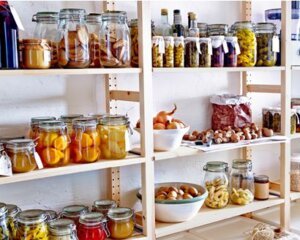How to preserve Food Raw Material for longer shelf life
Preservation involves a change to the nature of a product that reduces the microbial load or limits the growth of microorganisms. The exact method of preservation used is dependent on the product, its effect on product safety, and the process facility in terms of power, space, equipment and hygiene.
It is the responsibility of the procurement officer to ensure that all the quality parameters of the procured raw material comply with the set specifications. Even after raw material has been procured unwanted contaminants can enter accidently or if precautions have not been taken during storage or transportation. To ensure that raw material is safe, following measures should be adopted.
-
- Transport and store consumable materials with covers. Separate and store consumable foods, raw materials and non food items.
- It is important that everything- hands, clothes worn by employees, cold storage area, and storage containers – be kept clean.
- Ensure that people handling food material wear mask, gloves, shoe covers and appropriate clean clothing all the time.
- Use containers made of food grade material to store raw paste and sauces.
- Use racks/pallets which are made of non-absorbent material, provided on the floor for keeping raw material.

- For a few foods, optimum storage conditions for maintaining flavour or texture may differ from optimum conditions for maximum shelf life. However, some of themethods commonly used to preserve raw ingredients for a longer shelf life have been listed below:Air tight packaging: Dry staples such as grains, flour, milk powder, seasonings, baking powder, baking soda, cereals should be stored in metal, glass or plastic air tight containers or polyliner bagsor drums to prevent raw ingredients from absorbing moisture.Aseptic Canning: Acidic foods such as tomato products, fruits, and fish should be aseptically canned to prevent microbial growth. Tinplate or ECCS (electrolytic chromium coated low carbon steel) can be used as a packaging material for cans.Dehydration: Drying or dehydration to remove moisture is another way to preserve food material. Osmotic dehydration, drum drying, hot air drying and foam mat drying are some of the techniques involved.
Radiation: Food irradiation is a process in which food products are exposed to a controlled amount of radiant energy to increase the shelf life of the food. Radiation processing such as gamma rays, electron beams & x-rays can be used for:
- disinfestations of grains, pulses, fruits and vegetables;
- sprout inhibition of tubers, bulbs & rhizomes;
- delay in ripening and senescence in fruits & vegetables;
- destruction of microbes responsible for food spoilage
Refrigeration&Cold Storage: High risks food such as meat, dairy products, eggs, cut fruits and vegetables, cookie dough, margarine should be stored at low temperatures to extend their shelf life.
Non Thermal Technologies: High Pressure Processing (HPP), Ohmic heating and Pulsed Electric Field (PEF) processing are some of the non-thermal technologies that can be used to preserve organoleptic and nutritional qualities in the food.

